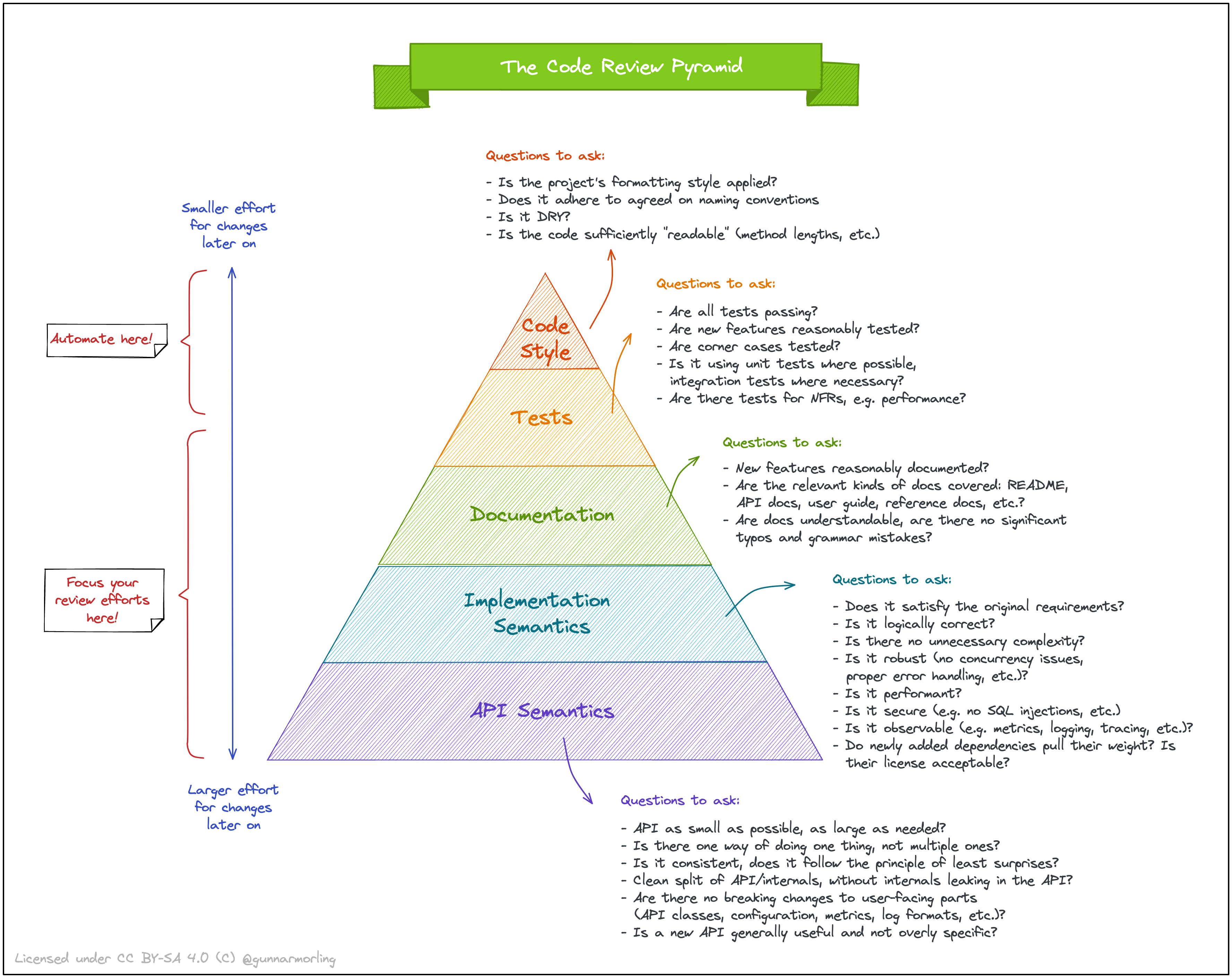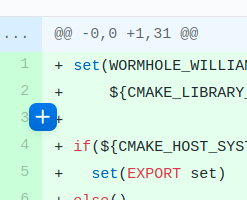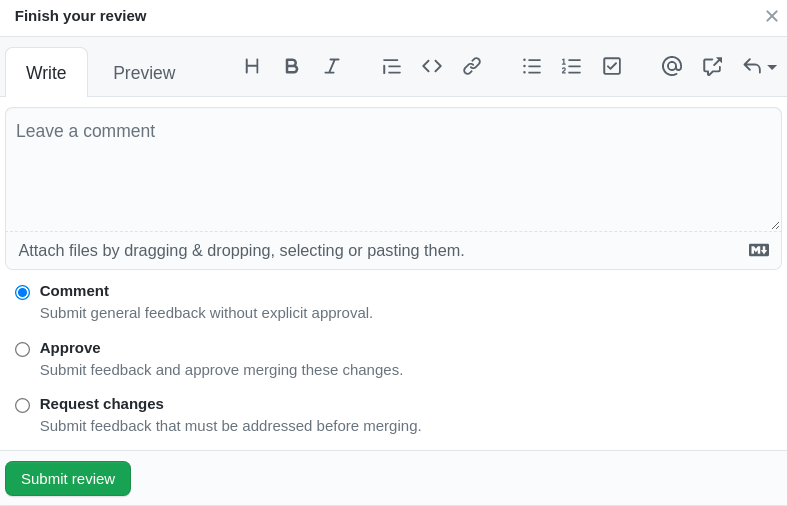Code Review Guidelines
Code Review Guidelines
This is a living document and will be updated as the ecosystem matures & grows.
Table of Contents
- The Code Review Pyramid
- Code Quality
- Code Reviews
- Branch Cleanup
- Doing Code Review Tips
- Resolving Comments
The Code Review Pyramid

The Pyramid above from this blog sums up some of the best practices. The rest of this file captures the approach to code reviews within Pocket Network.
Code Quality
tl;dr Code Quality is an art moreso than a science.
Code Quality can be a vague concept, as it usually addresses what is more the art side (vs. the science side) of software development. In this document, we outline a framework to guide that human judgement towards -- collectively -- better code.
There are often several technically correct ways to address a problem -- that is, the correct answer or behavior is produced. Selecting the "best" solution is often a matter of style. Sometimes, the best solution is one that fits the surrounding code in the most cohesive way.
Terms like maintainability or readability are used; these address the ability of other contributors to understand and improve the code. Unlike correctness or performance concepts, there's no single metric or mathematical solution that can be optimized to achieve better code quality. Thus, we rely on human judgement.
For decades, the IETF (Internet Engineering Task Force) has used the motto rough consensus and running code. This motto encapsulates (running code) that developers' core output is still software: if there is no code that runs and produces correct results, we have nothing. It also encapsulates (rough consensus) that we may not always precisely agree and that's okay.
Code Reviews
tl;dr Code Reviews are a necessary evil, and there are no specific guidelines that will university apply everywhere all the time.
One tactic often employed to produce maintainable or more-readable code is a code review. These can take many shapes and forms and often have goals beyond simply `code quality``.
Broadly speaking, code reviews involve developers looking at some proposed new code (or code changes). This is usually developers other than the author (although a self-review can also be employed). In many projects, such attention is a scarce commodity: most programmers would rather write code than read someone else's.
Remember, writing code is the fun part but reading code is work part, so try to make it as easy for the reviewer as possible.
Code Review Guidelines
All participants must adhere to the overall idea that the review is an attempt to achieve `better`` code. This is a vague statement on purpose.
Participants must be cautious in their criticism and generous with praise.
Participants must remember the scarcity of another developer's attention.
Expectations
Pull Request Authors: The author is responsible for tracking up-to-date next actions for a Pull Request to progress towards being merged.
Reviewers: Reviewers should prefer engaging in code review over starting new work (i.e. taking planned work items that haven't been started yet).
Reviewers (and prospective reviewers) are encouraged to engage in reviews of codebases outside the projects and technologies they use on a day-to-day basis (but not expected to provide an approving review).
Best Practices
Smaller PRs
Consider if it could be broken into smaller Pull Requests. If it is clear that it can be, summarize your thinking on how in your Review.
Ordering Commits
If the commits be (re)organized (i.e. reordered and/or amended) such that there is a commit at which the tests are passing prior to the conclusion of the main change, that's a signal that there's likely a logic split which can be made at that point in such a (re)arrangement.
Approving PRs
Use the following guidelines to evaluate whether a Pull Request should be approved:
- Every Pull Request should have tests or justification otherwise; esp. bug fixes.
- Every Pull Request should have at least 1 approval from a team member internal or external to the project. Exceptions made by repository maintainer(s), as necessary, on a case-by-case basis.
Review Comments
tl;dr Use SOS, TECHDEBT, TECHDEBT(XXX), NIT if you think it'll help the author get context on the next steps.
When leaving review comments, consider if any of the following characterizations applies and prefix the comment, respectively:
NIT: Comment is a nitpickTECHDEBT: Comment should have a TECHDEBT comment w/o a ticketTECHDEBT(XXX): Comment should have a TECHDEBT comment but imporant enough that it requires a ticket to track the work in the near futureSOS: Show Stopper. You feel strongly enought that it needs to be addressed now.
During review, submit feedback using line comments (Fig1); prefer Add\[ing a\] single comment over Start[ing] a review (Fi2). Once a review has been started, the option to add single comments is removed. Preferring single comments allows feedback to happen even in the event of an interrupted review.
Figure 1: Inline Github Comment

Figure 2: Line Comment Dialog
Referencing Issues Across Repositories: When referencing issues from one repository, in another's Issues and Pull Requests, GitHub supports automatic links in markdown using the following format: <org name>/<repo name>#<issue or PR number>.
Finishing a Review
Write a summary of your observations and consider including positive remarks in addition to any constructive criticism.
If you observe a deviation from these practices or another reason that this change should not be merged, select request changes and include a summary of the observation(s), as well as any practice(s) you find them to be in conflict with, in the review body (Fig3).
If you don't feel comfortable giving approval or requesting changes but want to share a summary or observations of larger patterns in the codebase or the company, select "Comment" and submit your review (C).
Confirm that all items in the required checklist are checked or not applicable.
If you believe the Pull Request looks good to merge, select "Approve" and submit your review (Fig3).
Figure 3: Submitting A Review

Merging
- Utilize the
Squash & Mergefeature (maintain a clean history) - Copy the
Github PR Descriptioninto the commit message (add sufficient detail)
Authors are core members or regular external contributors:
- Core member needs to approve PR
- Author should merge in the PR themselves (following instructions above)
Authors are non-regular external contributors:
- Core member needs to approve PR
- Core member can merge PR on behalf of contributor (following instructions above)
Branch Cleanup
After a PR is merged in or a branch is no longer needed, the branch should be deleted. This avoid the buildup of too many old and unused branches that are no longer relevant.
However, it is sometimes useful to keep a branch in place.
- If you merged in a PR but want to keep the branch around, please leave a comment like this to make sure it is not removed.
- If your branch is not part of a PR, or should not be deleted by anyone but the owner, make sure to add a
do_no_deletein the branch name itself.
Doing Code Review Tips
Checkboxes
As you're reviewing a PR, you can select the Viewed checkbox to keep track of what you've reviewed or what has changed.
If you submit an uncomplete review, you can show the author which files you have or haven't reviewed up to that point
Changes Since Last Review
If you're coming back to a PR you've already reviewed, you can use the "Show changes since your last review" to only inspect the difference.
Merge with main - don't rebase and force push
As an author of a PR, rebasing, rewriting history and force pushing is okay until you have your first review. After that, it will lead to the error below to the reviewer if using the feature above. Please bias to doing a git merge main after at least one review has been completely.
Resolving Comments
- If the author left an actionable comment:
resolvethe comment when you've addressed it. - If the author left an actionable comment that you don't plan to address or need more information on:
do not resolvethe comment and leave a reply. If it will not be tended to, the author must resolve it. - Once all comments have been resolved, the author should
re-requesta review. - Once all comments have been resolved, the reviewer should
approvea review if they have no more comments.